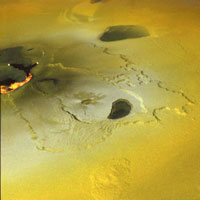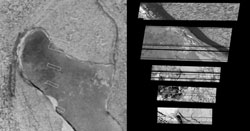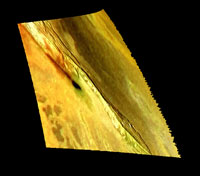
Travel
|
Volcanoes are abundant on Jupiter's moon Io NASA/Jet Propulsion Laboratory Abundant volcanoes, including some that turn on and off, and puzzling surface textures are some of the new findings from NASA's Galileo spacecraft during the closest flyby ever of Jupiter's moon Io.
Images and other data gathered by Galileo during a flyby of Io on February 22 will be released today at the American Geophysical Union's spring meeting in Washington, D.C. The high-resolution observations made by one of the instruments on Galileo, the near-infrared mapping spectrometer, revealed 14 volcanoes in a region that was previously known to have only four. The region covers about five percent of Io's surface and is about three times larger than Texas. Before the flybys, Io was known to have only about 81 active volcanoes. "Since the distribution
of active volcanoes on Io appears to be uniform, we can expect Io
to have some 300 active volcanoes, most of which have not been discovered," said Dr.
Rosaly Lopes- Gautier, research scientist at NASA's Jet
Scientists have detected changes in the months between the three different flybys in October 1999, November 1999 and February 2000. Some of the smaller, fainter volcanoes appear to turn on and off, changing from hot and glowing to cool and dim within a few weeks. The larger or brighter volcanoes tend to remain active for years or even decades, based on previous observations by Galileo and the Voyager spacecraft that flew through the Jovian system in 1979. Loki, the most powerful volcano in the solar system, was scanned by Galileo's photopolarimeter/radiometer during the October 1999 flyby and again this past February. These two close- up views showed Loki near the beginning and end of one of its periodic major eruptions.
"Most of the surface of its caldera, a region of more than 10,000 square kilometers (about 4,000 square miles) or half the size of Massachusetts, seems to have been covered by hot lava in the intervening four and a half months," said Dr. John Spencer of Lowell Observatory, Flagstaff, Ariz., co- investigator for the radiometer instrument. New images show that Chaac Patera has a caldera wall that is about 2.8 kilometers (1.7 miles) high with a 70-degree slope -- about twice as high and steep as the typical slopes of the Grand Canyon. "The wall rocks must be very strong to support this topography," said Dr. Alfred S. McEwen of the University of Arizona, Tucson, a member of the Galileo imaging team. "Each volcanic center on Io is proving to have unique characteristics." Observations also show a smaller caldera filled with bright white deposits containing sulfur dioxide that is purer than at any other place observed on Io. Scientists believe it may be a frozen layer of sulfur dioxide ice. One of the most spectacular
volcanic eruptions observed by Galileo was from Tvashtar Catena
in November 1999. The February images show that the eruption seen in November has waned,
but there is a new eruption with extremely hot lava The February Io flyby has yielded more images with higher resolution than previous flybys. They show unprecedented views of small surface areas that give new clues about the volcanic terrain but also reveal landforms that are perplexing to geologists. There are views of one surface area that appears eroded, showing thin, alternating bright and dark layers. Scientists don't yet understand how the layers formed and were eroded or how other plains textures on Io have formed. "There are processes on Io for which we have no terrestrial experience," said McEwen. "Strange new observations like these will provide fodder to current and future scientists for understanding the processes that have shaped this fascinating world." |
|
Topics:
Living | Health
| Money | Travel
| Services | Shopping Resources: Online Forums | Privacy Policy | Feedback Copyright © 2000-2002 Our Privacy Policy |



